-
Content Count
1,358 -
Joined
-
Last visited
Content Type
Profiles
Forums
Calendar
Posts posted by TriumphV8
-
-
There are "pros" and "cons" for a new steel bracket instead using the cast.
As Waldi said the cast one is milled down a little bit to get material to bore out at line broring.
Typical procedure to repair big ends of con rods. They become out of round often.
The disadvantage is that it is still that weak material that broke before.
The Rover V8 has steel caps and often problems with the register. They changed to a register at the the full heigt of the bracket and additionally bolt the bracket from the side to press the register together. And from there I heard about the problems line boring when half is aluminium and half is steel.
Steel and cast iron are closer together but there is still a difference. Needs good equipment, patience and skill to end up with a precise round hole there. Question remains is that necessary for a street engine.
-
There is a slit in the block that holts the bracket perfect in position.
I call this the register. Many cars have problems there, for example the
2.2 litre Lotus 4 cylinder 4 valve or the Rover V8 and recently I had a TR6
with problems. It seems there occure heavy forces when crank is rotating.
I would expect they made the bracket break and so this bracket can not be used any more
although the slit is prefectly pressed together.
In Germany Stefan Schamschulla did the job of making a new bracket and line boring.
As I heard of several of these repairs failed you should buy a measuring device from China
to check the out of round condition of the hole after repair.
Anyway I would do that job before sending the block for expensive repair to check all the bearings first.
And why not, if you can get a block for free, test all the brackets you have to see if you are lucky and one fits.
I would say max tolerance is 3/100mm, what is already pretty close to the play in the bearing, so that will be
the absolute limit.
I had a problem with the bolt in that area and material was pressed out 5/100mm in the thread area. I could cure that prefectly with Dremel and a rubber sanding grinder. Ended up at 1/100mm and engine is running strong since years.
-
Hi Matt,
the MU leaks at several positions, especially at the banjo in the middle of the diaphragm,
the two bolts that hold the cap and the three setting bolts under the cap. Besides the big cap to mu body
hold down with 4 bolts nothing should leak because it is sealed with the round edge of the diaphragm underneath.
Up to a normal amount leaking is pretty normal and is compensated by the suction of the manifolds.
The question what remains is "What is normal" difficult to judge from here but I would see the problem
not in this area. Definitely if okay there is nothing to feel or hear when engine is running.
My first recommendation to far away friends is to buy a complete ignition system from simon bbc,
complete with a Lucas sports coil and high tension leads to test. Take it with points and it will be under
100 Euros. Plug this in with a separate 12V line from the battery to first make sure the problem is not
ignition related.
My second recommendation is to fit a wideband AFR sensor to find out what goes on when engine is cold
and what will differ when getting warm. The easiest solution can be a locked enrichment system what can be
starting under the square plastic plate beside the mu where the lever arm is located. Does it fully come back
to the full load setting screw at the bottom?
You may remove the injectors and let the pump running. Check if they keep tight and do not let fuel. That is an indication of a problem with the sealing inside the mu.
Good luck and keep us informed!
-
Not much to do.
If you do not expect fuel pinking you can shave the head a little bit.
As you will loose some power from the valve inserts you can grind the inlet and outlet to compensate for that and make the step from runner to insert a little bit smoother.
The combustion chamber around the valves and around the plug can be grinded carefully not taken too much away, not more than the cylinder bore shows.
The exhaust area around the valve guide is pretty tight and can be grinded a little bit right and left from guide,
Valve seats can get the famous three angle valve job but all in all you always have to take care not to make the inserts to wide open, that they will pop out.
Good exhaust header at this stage will give around 3HP over the stock max, so not worth the effort.
The fan will catch around 3-5 Hp and maybe removed for the electric fan.
Do not expect too much. If you set the MU properly to AFR 12.7 and do all the things you will get around 150 - 155 HP because orginally the CP had only 136 and so you can have a nice increase of 14 hp in reality.
-
3 hours ago, Waldi said:
Andreas is an artist and understands machining better than many of us (me).
Keep posting!Waldi
So sweet! Many thanks but this time the balancing unit is from Apfelbeck:
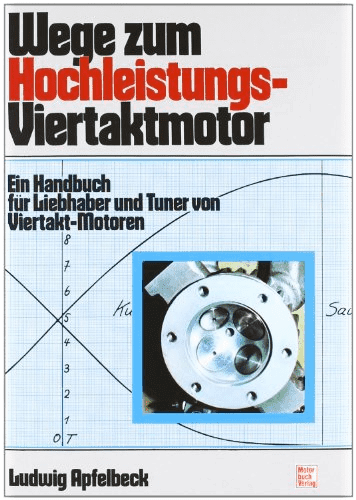
Unfortunately in a funny language but anyway worth to read (and understand)
-
I do balancing on all parts by myself.
The best pulley will not help if the fan is not properly balanced.
In my opinion it is not necessary to balance out the last 10th of a gram
but have all in limits, especially the clutch cover, front extension and fan.
This is a pulley prepared to accept the triggerwheel for EFI fuel injection.
It is simply balanced by gravitation.
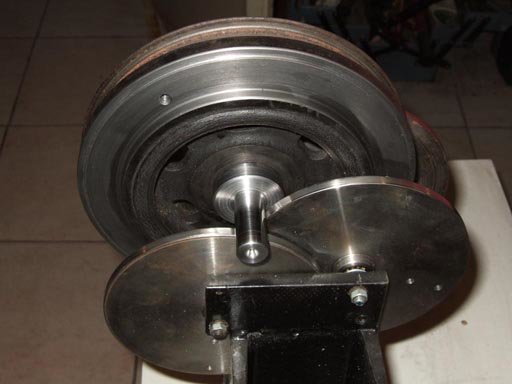
-
19 hours ago, Motorsport Mickey said:
AAaaaahhh our old friend the hand driven Symmetrical align boring tool, is that yours Andreas or did you just get used to it at where you work ?
Mick Richards
Oh, that is an very old milling machine I got from a machine shop.
The head can be turned 90 degrees for line boring in x-axis.
The advantage is that the table has a pretty long travel table in x-axis.
It can also mill a TR6 cylinder head perfectly.
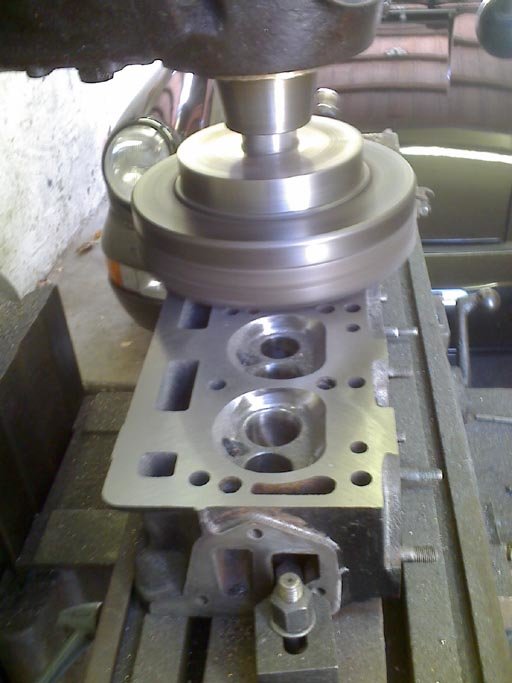
-
Did that by myself and as you drill all the bearings in one setup it is not that critical.
The drilling shaft is centered in the first and last hole and that the block and machine are brought into proper position.
As the first bearing always is worn to one side it is not that critical because in the middle is an unused area where the recess for the oil feed was. If that is gone I would inspect the second bearing and you may have to fiddle a little bit to take the outside/upper area of the bearing as a master because the bearing is worn towards the crankshaft. But I did not do that because my middle of the first bearing was untouched and could be used as a gauge.
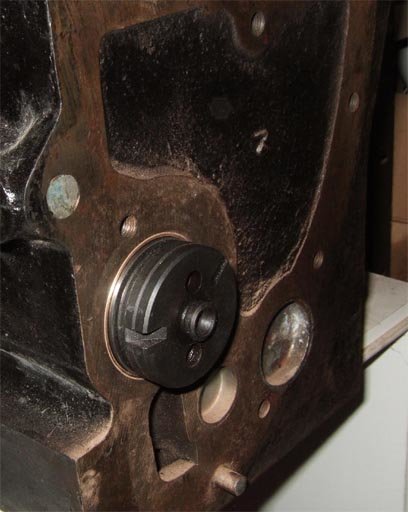
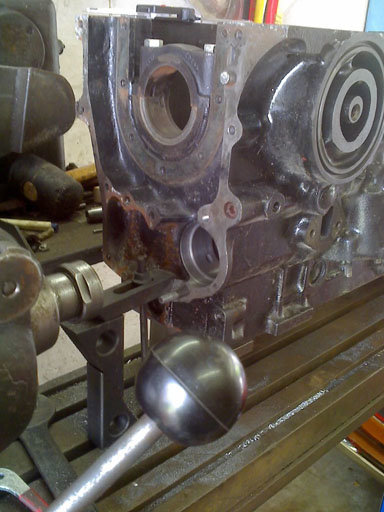
-
Try to lay a curved steel plate over the broken area and fit it with two new 1/4UNF screws left and right from original.
Put larger curved washers underneath
-
Two points:
The oil feed for the Opel pump is not that big deal. Many people claim additional oil feed for cylinder head is necessary and fit that. This is similar and a little blanking plate to feed the oil/air back from pump to engine is no big deal.
The air pump was invented by me because I have a hotter cam producing less vaccuum. That needs much more pedal forces and was simply uncomfortable. So just an improvement for hotter engines and not for "normal TR6"
The double diaphragm booster, even with the hotter cam, is just another world, it requieres pedal forces like a modern car with ABS.
So it depends what cam is fitted and what is aimed. Ladylike the brakes will become only with bigger booster, back to normal and good braking for sporty cams is possible with the vaccuum pump. Stock TRs will not improve noticeable with the pump.
-
-
I had the Opel Corsa D alternator with vaccuum pump in use
because pedal forces have never been good and with hotter cam
are a bit nasty when you swap from daily driver to TR6.
It was not that big deal, oil support came from additional oil feed for cylinder head
with reduced flow and back from air pump the hose was at the blanking plate for
the fuel pump. Worked nice for years until I went to double diaphragm booster from Volvo.
-
I have a cheap one from China, just below 200 Euros and it works nice.
No complains but never compaired with an expensive one if that can
do anything better.
-
As it worked properly before and fails now
the setup seems to be okay and something in the line
tank, fuel filter, fuel hose, pressure regulator and back
seems to be broken.
Before search and fiddle look for a Register EFI member with
some skill living close to you. He will find the fault easily and it seems to be not
expensive. Would expect blocked line to filter, the filter itself, the pump
or the pressure regulator.
-
Wonder why most want to cure the symptoms and not the cause.
A proper PI can idle for hours and as all cylinders seem to fire at idle
I would check first if fouling might be fuel or oil related.
If oil it might be the valve guide, cylinder bore or breather
if fuel I would check AFR to become things clear.
It is true, a hotter spark plug will not get black at idle but under full load it might get too hot.
-
On 6/20/2020 at 1:25 PM, astontr6 said:
My view is that triple Webers DCOE type can only be set up properly on a rolling road with an AFR stuck up the exhaust. Now the hard part is finding someone who still has the skill to set them up with that type of facility. Otherwise you will end up cursing and swearing. Having had a car with 2 DCOEs I know the problem well!
Bruce.
For this problem it will be the wrong way!
Rolling road or AFR measurement always takes all 6 carbs into account.
AFR for example if made rich by the first four carbs and leaned by the two in the rear,
will give a wrong intermediate figure.
So the result is not suitable for any decision and also power measurement will end with
the best performance the engine will give under these circumstances and not under proper
setting of all six carbs,
Before any testing is done you must be sure all six carbs are performing same way.
Unfortunately the rolling road will not cover the way we will drive under part throttle. The limit how lean we can go with the setup is indicated by several things, mainly the cam will need a richer mixture if hotter. So it is an individual driving test necessary to find the proper idle jets that meet the drivers preference and save fuel as good as possible.
If not needed I would set the carbs to 13AFR over the whole range and a little bit richer at full load.
It will take some more fuel but the setup is quickly done.
I would not expect some more performance on a rolling road from a TR6 set by me on the street compared
to the rolling road because we know the ignition advance very well. Although I do not know the absolute number
in BHP the setting on the street is perfect if you know what you are doing.
-
Just a simple idea:
Check 5&6 for air leak....
-
If fuel bowl height is correct next step is to check idle setscrews and progression holes.
Backfire of 5&6 while 1-4 is rich indicates that there is something severly wrong,
not only setting the idle screws but systematic because backfire means lean mixture.
Backfire when opening throttle a little bit is indicated to idle system and misfire at large
opening is related to main system including venturi and mixer behind. That must be bolted
properly and oriented correctly to be pressed upwards.
-
3 hours ago, Stagpowered said:
I would have thought it would be possible to make a mechanical link to the maximum fuel stop on the bottom of the metering unit. This is the little screw with the lock nut and the flats on the thread.
Interesting that this comes from a Stag Fan.
I know from The Stag Pope Dieter in the NRW Area that he did such a thing on his PI
setting the fuel stop to lean and added an electric main beam adjuster that pulls a rod in and out to the
enrichment lever. He could now adjust the lever with a two way switch how much the lever is pulled.
If done properly and movement is not too coarse this will do a nice job.
Anyway a engine set lean will not be killed in the mountains, it runs a bit ugly but thats it.
In addition as to be seen in Tom's picture on top of the hill it is often cold what has the opposite
effect of altitude on the mixture.
It is all a question how much oxygen parts are in a litre of air. Warm air expands and air with lower pressure
expands, too. Also the air gets thinner and can better flush through the inlet
but that does not fully compensate the loss of oxygen parts.
-
This will bring up more trouble than it helps!
The MU must meet the engine requirements.
Lucas had three different sets of springs in use what means
there are more than three versions produced.
What we will need in the Alps is a full load reduction of fuel what is not done
by the above hand controlled system. That would be nice to meet different air
temperature and air pressure when cruising with part throttle.
Anyway as Waldi said all requires a Lambda sensing unit.
Some are affected more from high altitude than others. Reason is simply that PI is quite thirsty when set up
for maximum performance. So I did see several TRs that go as lean as Lambda 0.94 at full load.
WIthout any trouble you can go in the Alps up to Lambda 0.82. So climbing up the performance will rise
for some 100 metres of altitude and than engine gets thirsty but does not stall.
Webers too dislike different altitudes and air temps. They simply perform quite well that some missing horses
do not play that role compared to a US twin carb..... Anyway also they suffer more if set at sea level on a cold day
already to Lambda 0.85.....
-
Interesting!
more a religion than real reasons for or against DCOE.
There are about 135 different DCOE ex works ever built and most are
for four cylinders and from that the first goal must be to get three similar carbs.
Many things can be swapped but not the progression holes.
They should be same number, position and size.
Rest is more or less some work and spending a lot of money for jets.
As nearly all can be changed all must be checked otherwise its not good.
From that point it might be interesting to buy 3 Chinese DCOE, never did so
and never heard anything about them.
Would start getting engine idle with mixture screws open in proper turns. Say that because not all
require 1,5revs, there are also those setscrews with different cones availiable. Than going on with
a wideband controller maybe Innovate setting full load AFR to 12.7. Between test drives checking fuel bowl height.
All in all EFI is much more comfortable and cheap to set up but requieres more skil to fit compared with DCOE
Just from the power there is not much difference, but that will rise with small venturis to get a better daily driver.
Mine had 32mm venturis and engine will stall when opened up at 2000rpm, needs a skilled driver.
-
There is a problem where to put the calipers.
I have a nice set from Nissan where the disc bolts directly on the TR.
Unfortunately all my calipers I tried from Ebay move much too far to the inside
because they have a single piston and the handbrake facility inside.
On top it will interfear with the inner wing or the bump stop.
More forward it will hit the spring.
Only position is backwards where my car has telescopic dampers.
Underside will work but is ugly.
I will not follow the Goodparts solution with a separate handbrake caliper.
I will have a drum brake inside for handbrake and a little two piston caliper
on top. Right now I am looking for a caliper that fits.
The advantage is that the pedal travel and feeling of the brake will be better
and simply it is nice to have......
Braking must not be better because that would mean brake balance is out of order
and although rear brake might need a little bit more it might end up quickly with a nasty
overtaking of rear....
if done too much. So beware!
-
I have a cheap dizzy for the TR6 and one for the V8.
The TR6 is with points.
I have that with a full ignition wiring for testing purpose ready to use and
it does a pretty good job for years.
If worried about advamce curve I would mark the 30 degree full advance on the pulley
and check what the dizzy will do at high revs. If necessary I would adjust the dizzy at idle
to achieve something between 30 to 32 degrees full advance in total.
Rest does not matter for a limited usage.
Part throttle advance is for crispy engine response and fuel economy,
so can be left open. It does no harm to the engine if not in use.
It requires a special pickup point at the carbs not to let advance at idle
but provides correct additional advance when throttle plates are a bit open.
That is why PI does not have that and can not be added easily.
123tune has a function to "simulate" such a pickup point that
part throttle advance is possible with PI and Weber DCOE.
Unfortunately 123tune is very, very lazy on reaction on changing vaccuum and so you can
add this function to PI and Weber but do not get completely happy because if you put the pedal down
123 is too lazy to follow the new condition quickly enough and fuel pinking will occure.
-
First of all you must find true TDC and mark it.
I do that always and mark on the flywheel.
I am not confident in the pulley.
Does not make sense to fight for the last degree if the rubber on the pulles lets it move.
Advance the cam will add low end, retard adds top end performance.
+/- 1 degree from my view is fully okay and might be better than works tolerances.
As mentioned above the chain stretches and so I am friend of cam advance.


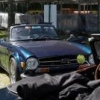
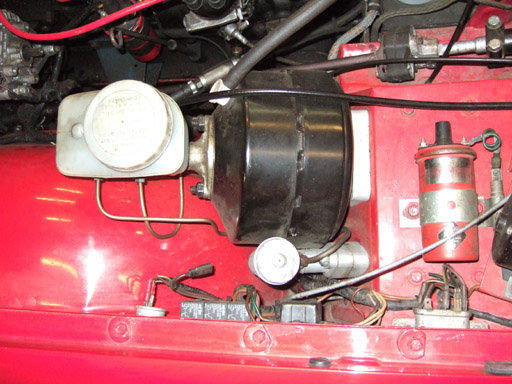
EFI plumbing
in General TR Technical
Posted
If you want to use a swirl pot to provide fuel in a long corner with less fuel in the tank you must make sure that there is sufficient fuel in the pot for the whole corner while the low pressure pump pumps air and not fuel into the pot.
So it is unwise to return the overflow to the fuel tank as that is too much loss and will dry the pot very quickly.
At the bottom the high pressure pump must take fuel, in the middle the fresh fuel from the low pressure pump must come in and on top the air and overflow fuel must go back to the fuel tank.
As a hint I would recommend to use special rubber hoses like the Gates Barricade and use steel pipes where possible otherwise there might be a lot of fuel smell from the lot of rubber hoses in the trunk.
Take into account to use a MegaSquirt or similar with wideband AFR control and get rid of the air metering unit. I have that in my Rover V8 for 20 years and it is very reliable.